Land Use/Cover Change Prediction Based on a New Hybrid Logistic-Multicriteria Evaluation-Cellular Automata-Markov Model Taking Hefei, China as an Example
Abstract
:1. Introduction
2. Materials and Methods
2.1. Study Area
2.2. Data Processing
2.2.1. Data
2.2.2. Processing Procedures
2.3. Methods
2.3.1. LUC Mapping and Its Dynamic Changes
2.3.2. Determination of the Driving Factors and Optimal Simulation Units
2.3.3. Simulation and Validation
3. Results
3.1. Classification and LUCC
3.1.1. LUC Maps
3.1.2. Changes in Land Use
3.2. Simulation Factors and the Optimal Simulation Unit
3.3. Simulation Results and Accuracy Evaluation
3.3.1. Simulation Results of Different Models
3.3.2. Accuracy Comparison
3.4. Predicted Land Use Pattern of 2025
4. Discussion
4.1. LUC Detection, Prediction, and Their Driving Forces
4.2. Performance of Different Models
4.3. Reproducibility, Limitations, and Future Work
5. Conclusions
Author Contributions
Funding
Data Availability Statement
Acknowledgments
Conflicts of Interest
Abbreviations
| IGBP | International Geosphere-Biosphere Programme |
| IHDP | International Human Dimensions Programme on GlobalEnvironmental Change |
| LUCC | Land Use/Cover Change |
| CA | Cellular automata |
| CM | CA–Markov |
| LCM | Logistic–cellular automata–markov |
| LR | Logistic regression |
| BLR | Binary logistic regression |
| MCE | Multicriteria evaluation |
| MCM | MCE–CA–Markov |
| LMCM | Logistic–multi-criteria evaluation–cellular automata–markov |
| LUC | Land use/cover |
| USGS | United States Geological Survey |
| DEM | Digital elevation model |
| NASA | National Aeronautics and Space Administration |
| GDP | Gross domestic product |
| API | Application programming interface |
| COST | Cosine function of the solar zenith angle (theta) |
| LST | Land surface temperature |
| NDVI | Normalized difference vegetation index |
| EVI | Enhanced vegetation index |
| GDVI | Generalized difference vegetation index |
| IDW | Inverse distance weight |
| WGS84 | World Geodetic System 1984 |
| UTM | Universal Transverse Mercator grid system |
| ROIs | Regions of interests |
| TS | Training set |
| VS | Verification set |
| OA | Overall accuracy |
| KC | Kappa coefficient |
| PA | Producer accuracy |
| UA | User accuracy |
| TOL | Tolerance |
| VIF | Variance inflation factor |
| ROC | Receiver operating characteristic |
| AUC | Area under the ROC Curve |
| AHP | Analytic hierarchy process |
| WLC | Weighted linear combination |
| Kno | Kappa for no information |
| Kstandard | Kappa standard |
| Klocation | Kappa location |
| AI | Artificial intelligence |
Appendix A. Confusion Matrices of Land Use/Cover Mapping Dated 2010, 2015, and 2020
| Class | Producer Accuracy (Percent) | User Accuracy (Percent) | Producer Accuracy (Pixels) | User Accuracy (Pixels) |
|---|---|---|---|---|
| Waters | 93.20 | 96.51 | 1356/1455 | 1356/1405 |
| Built-up areas | 98.79 | 95.13 | 1386/1403 | 1386/1457 |
| Croplands | 99.82 | 91.41 | 15,527/15,555 | 15,527/16,987 |
| Woodlands | 94.45 | 99.96 | 15,527/25,887 | 24,450/24,459 |
| Grasslands | 45.16 | 36.84 | 14/31 | 14/38 |
| Barelands | 44.44 | 100.00 | 12/27 | 12/12 |
| Class | Producer Accuracy (Percent) | User Accuracy (Percent) | Producer Accuracy (Pixels) | User Accuracy (Pixels) |
|---|---|---|---|---|
| Waters | 98.83 | 98.26 | 678/686 | 678/690 |
| Built-up areas | 99.59 | 91.20 | 3847/3863 | 3847/4218 |
| Croplands | 99.10 | 97.63 | 12,879/12,996 | 12,879/13,191 |
| Woodlands | 99.04 | 100.00 | 33,551/33,876 | 33,551/33,551 |
| Grasslands | 34.69 | 100.00 | 31/98 | 34/34 |
| Barelands | 0.00 | 0.00 | 0/165 | 0/0 |
| Class | Producer Accuracy (Percent) | User Accuracy (Percent) | Producer Accuracy (Pixels) | User Accuracy (Pixels) |
|---|---|---|---|---|
| Waters | 69.71 | 98.89 | 1335/1915 | 1335/1350 |
| Built-up areas | 99.59 | 94.29 | 1469/1475 | 1469/1558 |
| Croplands | 99.92 | 93.46 | 10,436/10,444 | 10,436/11,166 |
| Woodlands | 99.14 | 99.98 | 21,822/22,011 | 21,822/21,827 |
| Grasslands | 51.16 | 97.78 | 44/86 | 44/45 |
| Barelands | 88.10 | 100.00 | 111/126 | 111/111 |
Appendix B
| Year | Annual Rainfall (mm) | Rainfall from September to February (mm) |
|---|---|---|
| 2009 | 1099.82 | 362.97 |
| 2010 | 1430.02 | 372.87 |
| 2011 | 1048.77 | 209.80 |
| 2012 | 1037.34 | 352.30 |
| 2013 | 1043.43 | 271.02 |
| 2014 | 1303.27 | 448.06 |
| 2015 | 1386.33 | 324.36 |
| 2016 | 1658.11 | 667.51 |
| 2017 | 1058.93 | 390.14 |
| 2018 | 1772.41 | 570.23 |
| 2019 | 651.00 | 283.21 |
| 2020 | 1530.60 | 359.67 |
| 2021 | 1194.82 | 279.15 |
Appendix C
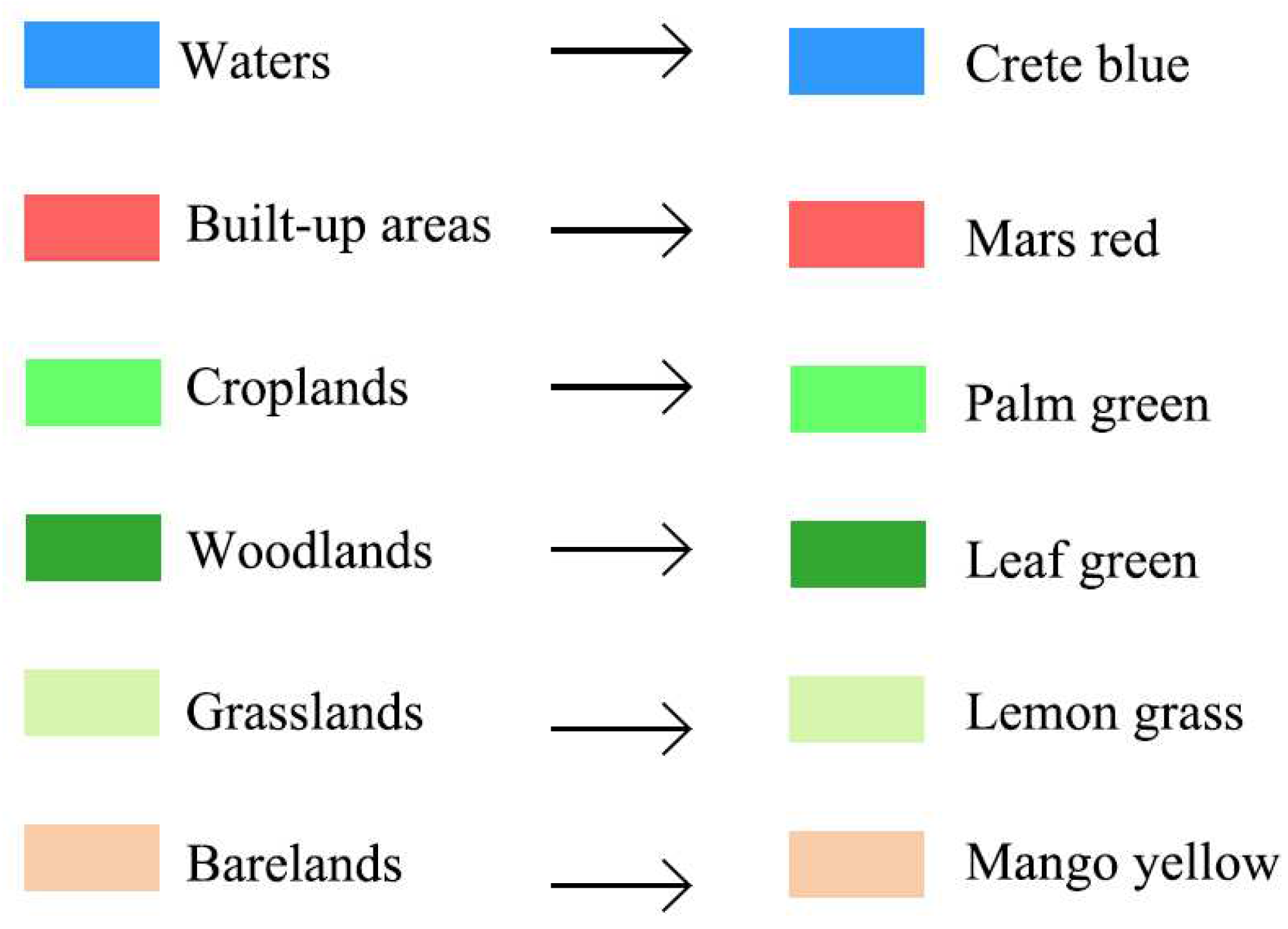
References
- Turner, B.L.; Skole, D.L.; Sanderson, S.; Fischer, G.; Fresco, L.; Leemans, R. Land-Use and Land-Cover Change, Science/Research Plan, Global Change Report; IIASA: Stockholm, Sweden; Geneva, Switzerland, 1995. [Google Scholar]
- Lambin, E.F. Land-Use and Land-Cover Change (LUCC)—Implementation Strategy; IGBP Report No. 48 and HDP Report No. 10. Cambridge; Cambridge University Press: Cambridge, UK, 1998. [Google Scholar]
- Lambin, E.F.; Turner, B.L.; Geist, H.J.; Agbola, B.S.; Angelsen, A.; Bruce, J.B.; Coomes, O.T.; Dirzo, R.; Fischer, G.; Folke, C.; et al. The causes of land-use and land-cover change: Moving beyond the myths. Glob. Environ. Change-Hum. Policy Dimens. 2001, 11, 261–269. [Google Scholar] [CrossRef]
- Li, X.B. International research trends on land use/land cover change, the core field of global environmental change research. Acta Geogr. Sin. 1995, 51, 553–558. [Google Scholar]
- Cai, Y.L. Land Use/Land Cover Change Studies: Seeking New Integrated Approaches. Geogr. Res. 2001, 20, 645–652. [Google Scholar]
- Li, F.; Li, D.Q.; Zhang, L.B.; Zhu, F.J. Comparative Study on Urbanization Process and Change of Resource and Environment in China, Japan and Korea. China Popul. Resour. Environ. 2015, 2, 125–131. [Google Scholar]
- Zeng, X.L.; Liu, Z.M. Rapid Urbanization and Social Trust: An Empirical Study Based on the Data of Chinese General Social Survey. Contemp. Financ. Economics 2021, 7, 13–23. [Google Scholar]
- Butcher, S. Urban equality and the SDGs: Three provocations for a relational agenda. Int. Dev. Plan. Rev. 2022, 44, 13–32. [Google Scholar] [CrossRef]
- Wu, W.; De Pauw, E.; Zucca, C. Using remote sensing to assess impacts of land management policies in the Ordos rangelands in China. Int. J. Digit. Earth 2013, 6 (Suppl. 2), 81–102. [Google Scholar] [CrossRef]
- Li, X.; Chen, G.; Liu, X.; Liang, X.; Wang, S.; Chen, Y.; Pei, F.; Xu, X. A New Global Land-Use and Land-Cover Change Product at a 1-km Resolution for 2010 to 2100 Based on Human–Environment Interactions. Ann. Assoc. Am. Geogr. 2017, 107, 1040–1059. [Google Scholar] [CrossRef]
- Yin, R.S.; Xiang, Q.; Xu, J.T.; Deng, X.Z. Modeling the Driving Forces of the Land Use and Land Cover Changes Along the Upper Yangtze River of China. Environ. Manag. 2010, 45, 454–465. [Google Scholar] [CrossRef]
- He, C.Y.; Zhang, J.Q.; Liu, Z.F.; Huang, Q. Characteristics and progress of land use/cover change from 1990 to 2018. Acta Geogr. Sin. 2021, 76, 2730–2748. [Google Scholar]
- Li, P.X.; Chen, W.; Zou, L.; Cai, X. Land Use/Cover Change and Its Ecological Environment Effects Based on Integrated Ecological Spatial Pattern: A Case Study of Yangtze River Delta. J. Environ. Sci. 2021, 41, 3905–3915. [Google Scholar]
- Forrester, J.W. Industrial Dynamics; Productivity Press: Cambridge, MA, USA, 1961. [Google Scholar]
- Wang, Q.F. System Dynamics; Tsinghua University Press: Beijing, China, 1994. [Google Scholar]
- Muller, M.R.; Middleton, J. A Markov model of land-use change dynamics in the Niagara Region, Ontario, Canada. Landsc. Ecol. 1994, 9, 151–157. [Google Scholar] [CrossRef]
- Yang, H.B.; Du, L.J.; Guo, H.L.; Zhang, J. Tai’an land use analysis and prediction based on RS and Markov model. Procedia Environ. Sci. 2011, 10, 2625–2630. [Google Scholar]
- Clarke, K.; Hoppen, S. A self-modifying cellular automaton model of historical. Environ. Plan B 1997, 24, 247–261. [Google Scholar] [CrossRef]
- Barredo, J.I.; Kasanko, M.; McCormick, N.; Lavalle, C. Modelling dynamic spatial processes: Simulation of urban future scenarios through cellular automata. Landsc. Urban Plan 2003, 64, 145–160. [Google Scholar] [CrossRef]
- Schelhorn, T.; O’Sullivan, D.; Haklay, M.; Thurstain-Goodwin, M. STREETS: An agent-based pedestrian model. In Proceedings of the Computers in Urban Planning and Urban Management, Venice, Italy, 8–11 September 1999; pp. 8–11. [Google Scholar]
- Parker, D.C.; Berger, T.; Manson, S.M. Agent-Based Models of Land-Use and Land-Cover Change, Report and Review of an International Workshop, Irvine, California, USA, 4–7 October 2001; LUCC Report Series No 6; LUCC International Project Office: Louvain-la-Neuve, Belgium, 2002; p. 124. [Google Scholar]
- Verburg, P.H.; Soepboer, W.; Veldkamp, A.; Limpiada, R.; Espaldon, V.; Sharifah, S.A. Mastura. Modeling the spatial dynamics of regional land use: The CLUE-S Model. Environ. Manag. 2002, 30, 391–405. [Google Scholar] [CrossRef]
- Cai, Y.M.; Liu, Y.S.; Yu, Z.R.; Verburg, P.H. Progress in spatial simulation of land use change CLUE-S model and its application. Prog. Geogr. 2004, 23, 63–71. [Google Scholar]
- López, E.; Bocco, G.; Mendoza, M.; Duhau, E. Predicting Land-Cover and Land-Use Change in the Urban Fringe: A Case in Morelia City, Mexico. Landsc. Urban Plan. 2001, 55, 271–285. [Google Scholar] [CrossRef]
- Lambin, E.F.; Geist, H.; Rindfuss, R.R. Land-Use and Land-Cover Change; Springer: Berlin/Heidelberg, Germany, 2006. [Google Scholar]
- Batty, M.; Xie, Y. From cells to cities. Environ. Plan. B Plan. Des. 1994, 21, 531–548. [Google Scholar] [CrossRef]
- White, R.; Straatman, B.; Engelen, G. Planning scenario visualization and assessment: A cellular automat a based integrated spatial decision support system. In Spatially Integrated Social Science; Oxford University Press: Oxford, UK, 2004; pp. 420–442. [Google Scholar]
- Dai, Y.Z.; Yang, J.X.; Gong, J.; Ye, J.; Li, J.Y.; Li, Y. AutoPaCA: Coupling process and spatial pattern to simulate urban growth. J. Geo-Inf. Sci. 2022, 24, 87–99. [Google Scholar]
- Lin, Z.Q.; Peng, S.Y. Comparison of multimodel simulations of land use and land cover change considering integrated constraints- A case study of the Fuxian Lake basin. Ecol. Indic. 2022, 142, 109254. [Google Scholar] [CrossRef]
- Zhang, S.; Yang, P.; Xia, J.; Wang, W.; Cai, W.; Chen, N.; Hu, S.; Luo, X.; Li, J.; Zhan, C. Land use/land cover prediction and analysis of the middle reaches of the Yangtze River under different scenarios. Sci. Total Environ. 2022, 833, 155238. [Google Scholar] [CrossRef] [PubMed]
- Wu, F.L. Calibration of stochastic cellular automata: The application to rural-urban land conversions. Int. J. Geogr. Inf. Sci. 2002, 16, 795–818. [Google Scholar] [CrossRef]
- Tobler, W.R. Cellular geography. In Philosophy in Geography; Springer: Berlin/Heidelberg, Germany, 1979; pp. 379–386. [Google Scholar]
- Clarke, K.C.; Hoppen, S.; Gaydos, L. A self-modifying cellular automata model of historical urbanization in the San Francisco Bay area. Environ. Plan. B Plan. Des. 1997, 24, 247–261. [Google Scholar] [CrossRef]
- Elena, B.; Arnaldo, C.; Enrico, R. The diffused city of the Italian North-East: Identification of urban dynamics using cellular automata urban models. Comput. Environ. Urban Syst. 1998, 22, 497–523. [Google Scholar]
- Huang, X.L.; Liu, D.Y.; Feng, Z.K.; Qiu, Q.; Miao, J. Research on Land Use Prediction in Tianjin Based on CA Markov Model. China J. Agric. Sci. Technol. 2012, 5, 84–89. [Google Scholar]
- Araya, Y.H.; Cabral, P. Analysis and modeling of urban land cover change in Setubal and Sesimbra, Portugal. Remote Sens. 2010, 2, 1549–1563. [Google Scholar] [CrossRef]
- Etemadi, H.; Smoak, J.M.; Karami, J. Land use change assessment in coastal mangrove forests of Iran utilizing satellite imagery and CA–Markov algorithms to monitor and predict future change. Environ. Earth Sci. 2018, 77, 208. [Google Scholar] [CrossRef]
- Wu, F.L.; Yeh, A.G. Changing spatial distribution and determinants of land development in Chinese cities in the transition from a centrally planned economy to a socialist market economy: A case study of Guangzhou. Urban Stud. 1997, 34, 1851–1879. [Google Scholar] [CrossRef]
- Liu, X.P.; Li, X.; Peng, X.O. Application of “niche” cellular automata in land sustainable planning model. Acta Ecol. Sin. 2007, 27, 2391–2402. [Google Scholar]
- Eastman, J.R. IDRISI 15 Andes, Guide to GIS and Image Processing; Clark University: Worcester, MA, USA, 2006. [Google Scholar]
- Eastman, J.R. IDRISI Help System. IDRISI Taiga; Clark University: Worcester, MA, USA, 2009. [Google Scholar]
- Wang, Q.; Wang, H.J.; Chang, R.H.; Zeng, H.R.; Bai, X.P. Dynamic simulation patterns and spatiotemporal analysis of land-use/land-cover changes in the Wuhan metropolitan area, China. Ecol. Model. 2022, 464, 109850. [Google Scholar] [CrossRef]
- Lee, G.K.; Chan, E.H. The analytic hierarchy process (AHP) approach for assessment of urban renewal proposals. Soc. Indicat. Res. 2008, 89, 155–168. [Google Scholar] [CrossRef]
- Zeleny, M. Multiple Criteria Decision Making; McGraw-Hill: New York, NY, USA, 1982. [Google Scholar]
- Voogd, H. Multi Criteria Evaluation for Urban and Regional Planning; Pion: London, UK, 1983. [Google Scholar]
- Eastman, J.R.; Jiang, H.; Toledano, J. Multi-criteria and multi-objective decision making for land allocation using GIS. In Multi-Criteria Analysis for Land-Use Management; Beinat, E., Nijkamp, P., Eds.; Kluwer Academic Publishers: Dordrecht, The Netherlands, 1983; pp. 227–251. [Google Scholar]
- Wu, F.L.; Webster, C.J. Simulation of land development through the integration of cellular automata and multi-criteria evaluation. Environ. Plann. B. 1998, 25, 103–126. [Google Scholar] [CrossRef]
- Nath, B.; Wang, Z.; Ge, Y.; Islam, K.; Singh, R.P.; Niu, Z. Land Use and Land Cover Change Modeling and Future Potential Landscape Risk Assessment Usin Markov-CA Model and Analytical Hierarchy Process. ISPRS Int. J. Geo-Inf. 2020, 9, 134. [Google Scholar] [CrossRef]
- He, C.Y.; Chen, J.; Shi, P.J.; Fan, Y.D. Urban Expansion Model of Metropolitan Area: A case study of Beijing Urban Expansion Simulation. Acta Geogr. Sin. 2003, 58, 294–304. [Google Scholar]
- Lu, Y.T.; Wu, P.H.; Ma, X.S.; Li, X.H. Detection and prediction of land use/land cover change using spatiotemporal data fusion and the Cellular Automata–Markov model. Environ. Monit. Assess. 2019, 191, 68. [Google Scholar] [CrossRef]
- Li, Y.; Liu, Y.; Manjula, R.; Zhang, H.; Zhou, R. Examining Land Use/Land Cover Change and the Summertime Surface Urban Heat Island Effect in Fast-Growing Greater Hefei, China: Implications for Sustainable Land Development. ISPRS Int. J. Geo-Inf. 2020, 9, 568. [Google Scholar] [CrossRef]
- Sun, J.; Ongsomwang, S. Impact of Multitemporal Land Use and Land Cover Change on Land Surface Temperature Due to Urbanization in Hefei City, China. ISPRS Int. J. Geo-Inf. 2021, 10, 809. [Google Scholar] [CrossRef]
- Hefei Municipal Statistics Bureau. The 2021 Report of Demographic Census in Hefei. Available online: https://tjj.hefei.gov.cn/tjnj/2021nj/index.html (accessed on 12 January 2022).
- Wu, W.C. Application de la Geomatique au Suivi de la Dynamique Environnementale en Zones Arides. Ph.D. Thesis, Université Panthéon-Sorbonne-Paris I, Paris, France, 2003. [Google Scholar]
- Wu, W.C.; De Pauw, E.; Hellden, U. Assessing woody biomass in African tropical savannas by multiscale remote sensing. Int. J. Remote Sens. 2013, 34, 4525–4549. [Google Scholar] [CrossRef]
- Bey, A.; Jetimane, J.; Lisboa, S.N.; Ribeiro, N.; Sitoe, A.; Meyfroidt, P. Mapping smallholder and large-scale cropland dynamics with a flexible classification system and pixel-based composites in an emerging frontier of Mozambique. Remote Sens. Environ. 2020, 239, 111611. [Google Scholar] [CrossRef]
- Lan, H.; Stewart, K.; Sha, Z.; Xie, Y.; Chang, S. Data Gap Filling Using Cloud-Based Distributed Markov Chain Cellular Automata Framework for Land Use and Land Cover Change Analysis: Inner Mongolia as a Case Study. Remote Sens. 2022, 14, 445. [Google Scholar] [CrossRef]
- Chavez, P.S. Image-Based Atmospheric Correction-Revisited and Improved. Photogram. Eng. Remote Sens. 1996, 62, 1025–1036. [Google Scholar]
- Xie, L.F.; Wu, W.C.; Huang, X.L.; Ou, P.H.; Lin, Z.Y.; Wang, Z.L.; Song, Y.; Lang, T.; Huangfu, W.C.; Zhang, Y.; et al. Mining and Restoration Monitoring of Rare Earth Element (REE) Exploitation by New Remote Sensing Indicators in Southern Jiangxi, China. Remote Sens. 2020, 12, 3558. [Google Scholar] [CrossRef]
- Li, J.; Wu, W.C.; Fu, X.; Jiang, J.H.; Liu, Y.X.; Zhang, M.; Zhou, X.T.; Ke, X.X.; He, Y.C.; Li, W.J.; et al. Assessment of the Effectiveness of Sand-Control and Desertification in the Mu Us Desert, China. Remote Sens. 2022, 14, 837. [Google Scholar] [CrossRef]
- Chander, G.; Markham, B.L.; Helder, D.L. Summary of current radiometric calibration coefficients for Landsat MSS, TM, ETM+, and EO-1 ALI sensors. Remote Sens. Environ. 2009, 113, 893–903. [Google Scholar] [CrossRef]
- USGS Landsat 8 (L8) Data Users Handbook. Department of the Interior US Geological Survey. 2015. Available online: https://www.doi.gov/hurricanesandy/usgs (accessed on 1 April 2022).
- Wu, W.C.; Zucca, C.; Karam, F.; Liu, G. Enhancing the performance of regional land cover mapping. Int. J. Appl. Earth Obs. Geoinf. 2016, 52, 422–432. [Google Scholar]
- Wu, W.C. The Generalized Difference Vegetation Index (GDVI) for Dryland Characterization. Remote Sens. 2014, 6, 1211–1233. [Google Scholar] [CrossRef]
- Rouse, J.W.; Hass, R.H.; Schell, J.A.; Deering, D.W. Monitoring Vegetation Systems in the Great Plains with ERTS, NASA/GSCF. In Third Earth Resources Technology Satellite–1 Symposium; National Aeronautics and Space Administration: Washington, DC, USA, 1974; Volume 1, p. 371. [Google Scholar]
- Huete, A.R.; Liu, H.Q.; Batchily, K.; Leeuwen, W. A comparison of vegetation indices global set of TM images for EOS-MODIS. Remote Sens. Environ. 1997, 59, 440–451. [Google Scholar] [CrossRef]
- Gong, G.; Mattevada, S.; O’Bryant, S.E. Comparison of the accuracy of kriging and IDW interpolations in estimating groundwater arsenic concentrations in Texas. Environ. Res. 2014, 130, 59–69. [Google Scholar] [CrossRef]
- Milillo, T.M.; Gardella, J. Spatial Analysis of Time of Flight−Secondary Ion Mass Spectrometric Images by Ordinary Kriging and Inverse Distance Weighted Interpolation Techniques. Anal. Chem. 2008, 80, 4896–4905. [Google Scholar] [CrossRef]
- Munyati, C.; Sinthumule, N.I. Comparative suitability of ordinary kriging and Inverse Distance Weighted interpolation for indicating intactness gradients on threatened savannah woodland and forest stands. Environ. Sustain. Indic. 2021, 12, 100151. [Google Scholar] [CrossRef]
- Spokas, K.; Graff, C.; Morcet, M.; Aran, C. Implications of the spatial variability of landfill emission rates on geospatial analyses. Waste Manag. 2003, 23, 599–607. [Google Scholar] [CrossRef] [PubMed]
- Rao, J.N.K.; Scott, A.J. A simple method for the analysis of clustered binary data. Biometrics 1992, 48, 577–585. [Google Scholar] [CrossRef] [PubMed]
- Pontius, R.G.; Schneider, L.C. Land-cover change model validation by an ROC method for the Ipswich watershed, Massachusetts, USA. Agric Ecosyst Environ. 2001, 85, 239–248. [Google Scholar] [CrossRef]
- Zhao, X.; Chen, W. Optimization of Computational Intelligence Models for Landslide Susceptibility Evaluation. Remote Sens. 2020, 12, 2180. [Google Scholar] [CrossRef]
- Leta, M.K.; Demissie, T.A.; Traenckner, J. Modeling and Prediction of Land Use Land Cover Change Dynamics Based on Land Change Modeler (LCM) in Nashe Watershed, Upper Blue Nile Basin, Ethiopia. Sustainability 2021, 13, 3740. [Google Scholar] [CrossRef]
- Yang, D.; Luan, W.X.; Li, Y.; Zhang, Z.C.; Tian, C. Multi-scenario simulation of land use and land cover based on shared socioeconomic pathways: The case of coastal special economic zones in China. J. Environ. Manag. 2023, 335, 117536. [Google Scholar] [CrossRef]
- Batty, M. Geocomputation Using Cellular Automata. In GeoComputation; Openshaw, S., Abrahart, R.J., Eds.; Taylor and Francis: London, UK, 2000; pp. 95–126. [Google Scholar]
- Miller, H.J. Geocomputation. In The SAGE Handbook of Spatial Analysis; Fotheringham, A.S., Rogerson, P.A., Eds.; Sage: London, UK, 2009; pp. 397–418. [Google Scholar]
- Clarke, K. Cellular Automata and Agent-Based Models. In Handbook of Regional Science; Fischer, M.M., Nijkamp, P., Eds.; Springer: Berlin/Heidelberg, Germany, 2014. [Google Scholar]
- Zhang, Y.; Ding, J.L. Prediction and Regulation of Future Trends in Oasis Land Use Change Resources and Environment in Arid Areas. J. Arid. Land Resour. Environ. 2006, 20, 29–35. [Google Scholar]
- Qiao, Z.; Jiang, Y.Y.; He, T.; Lu, Y.S.; Xu, X.L.; Yang, J. Land use change simulation: Progress, challenges, and prospects. Acta Ecol. Sinica. 2022, 42, 5165–5176. [Google Scholar]
- Huangfu, W.C.; Wu, W.C.; Zhou, X.T.; Lin, Z.Y.; Zhang, G.L.; Chen, R.X.; Song, Y.; Lang, T.; Qin, Y.Z.; Ou, P.H.; et al. Landslide Geo-Hazard Risk Mapping Using Logistic Regression Modeling in Guixi, Jiangxi, China. Sustainability 2021, 13, 9. [Google Scholar] [CrossRef]
- Ou, P.H.; Wu, W.C.; Qin, Y.Z.; Zhou, X.T.; Huangfu, W.C.; Zhang, Y.; Xie, L.F.; Huang, X.L.; Fu, X.; Li, J.; et al. Assessment of Landslide Hazard in Jiangxi Using Geo-information Technology. Front. Earth Sci. 2021, 9, 648342. [Google Scholar] [CrossRef]
- Ma, H.N. Research on the Development and Application of Urban Development Boundary Simulation System under the “Multi planning Integration”. Master’s Thesis, Henan Agricultural University, Zhengzhou, China, 2016. [Google Scholar]
- Mohamed, A.; Worku, H. Simulating urban land use and cover dynamics using cellular automata and Markov chain approach in Addis Ababa and the surrounding. Urban Clim. 2020, 31, 100545. [Google Scholar] [CrossRef]
- Menard, S. Applied Logistic Regression Analysis; No. 106; Sage: Thousands Oaks, CA, USA, 1995. [Google Scholar]
- Pontius, R.G. Quantification Error Versus Location Error in Comparison of Categorical Maps. Photogramm. Eng. Remote Sens. 2000, 66, 1011–1016. [Google Scholar]
- Wang, S.Q. Application of Weighted Markov Chain in Precipitation Prediction in Longnan Region. Math. Pract. Theory 2016, 46, 287–294. [Google Scholar]
- Wu, W.C.; Lambin, E.F.; Courel, M.F. Land use and cover change detection and modelling for North Ningxia, China. In Proceedings of the MapAsia 2002, Bangkok, Thailand, 7 August 2002. [Google Scholar]
- Wu, W.C.; Zhang, W.F. Present land use and cover patterns and their development potential in North Ningxia, China. J. Geogr. Sci. 2003, 13, 54–62. [Google Scholar] [CrossRef]
- Zhu, Y.; Li, B.; Lian, L.; Wu, T.; Wang, J.; Dong, F.; Wang, Y. Quantifying the Effects of Climate Variability, Land-Use Changes, and Human Activities on Drought Based on the SWAT-PDSI Model. Remote Sens. 2022, 14, 3895. [Google Scholar] [CrossRef]
- Buhaug, H.; Urdal, H. An urbanization bomb? Population growth and social disorder in cities. Glob. Environ. Change 2013, 23, 1–10. [Google Scholar] [CrossRef]
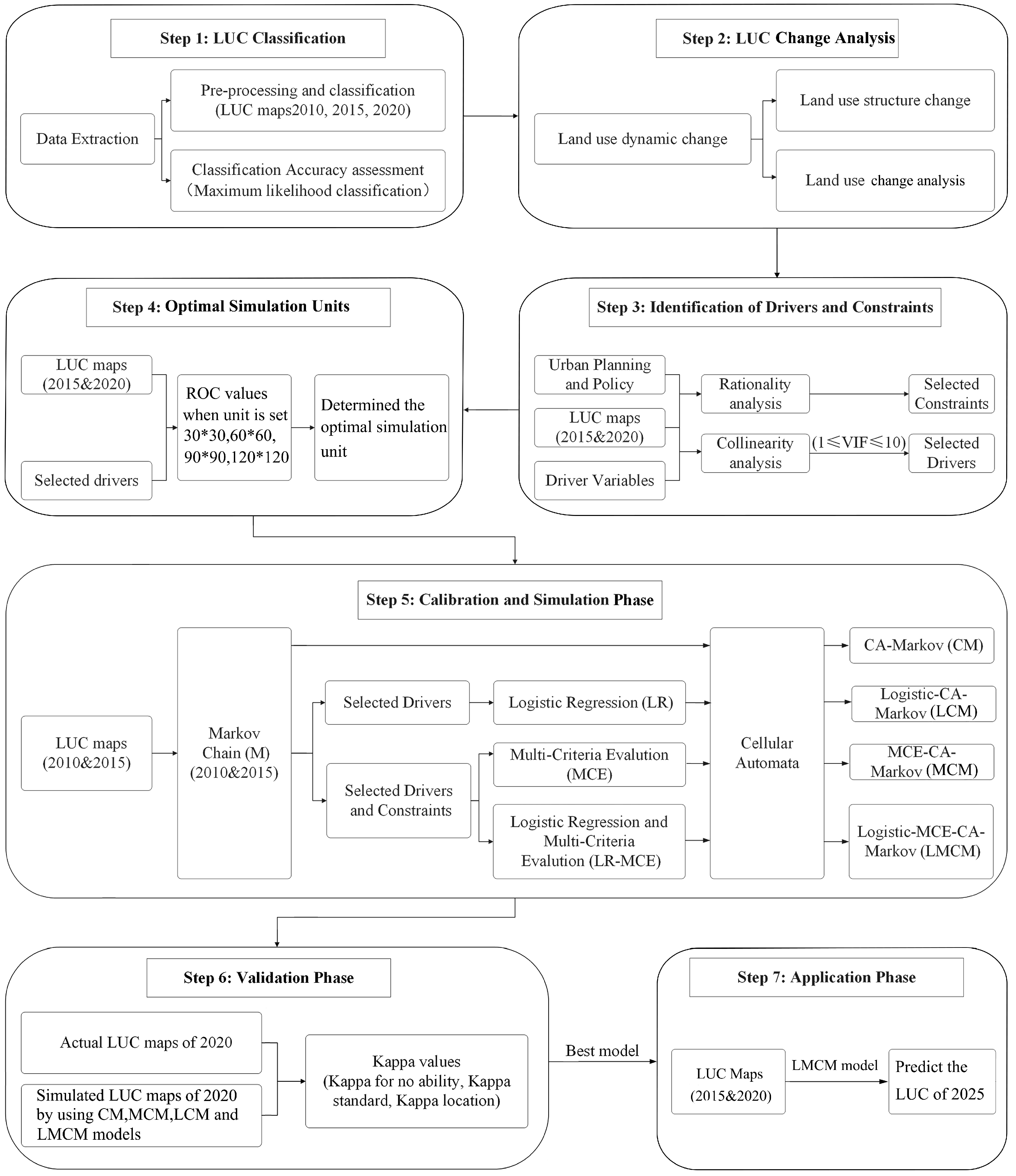
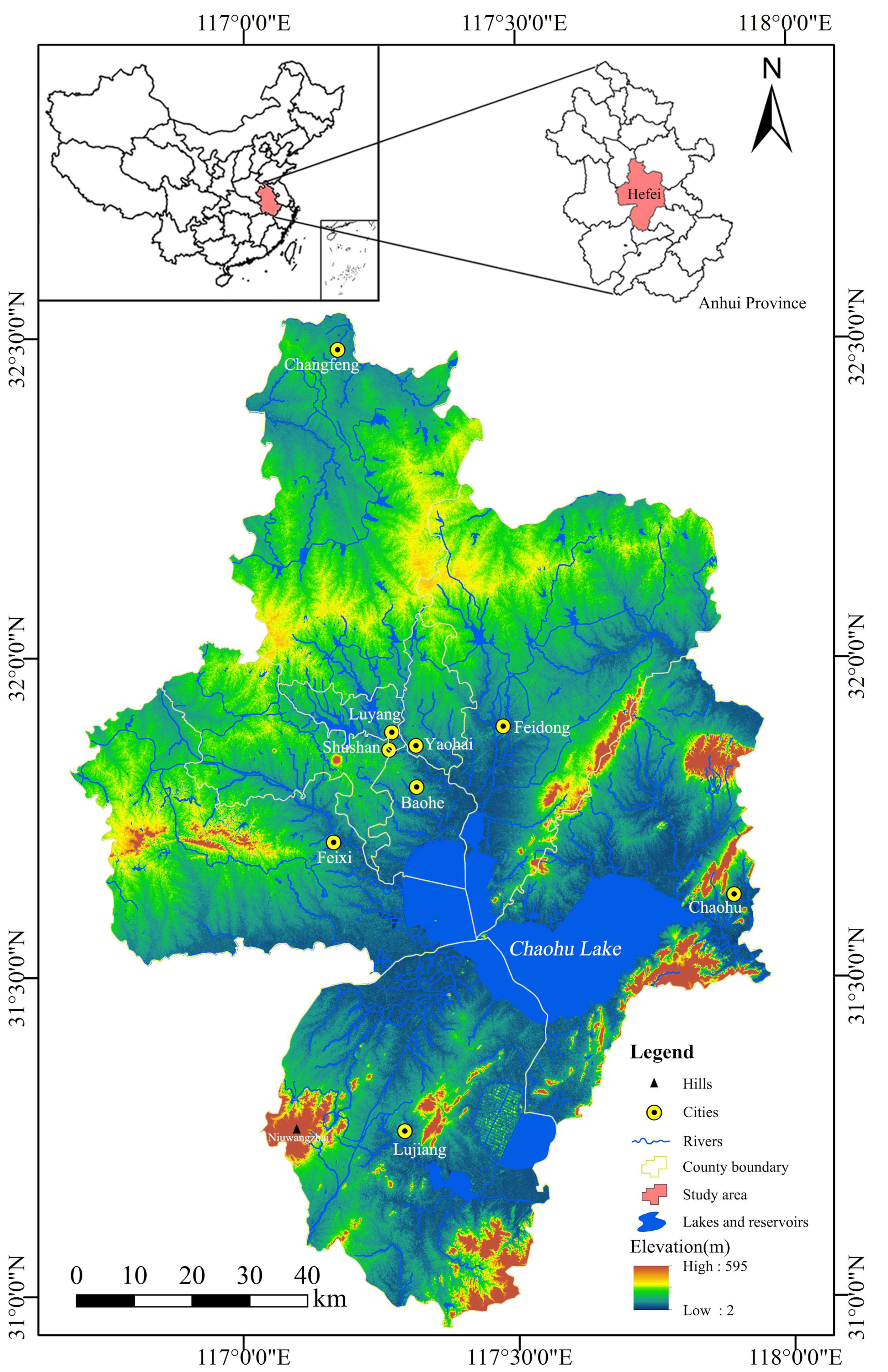



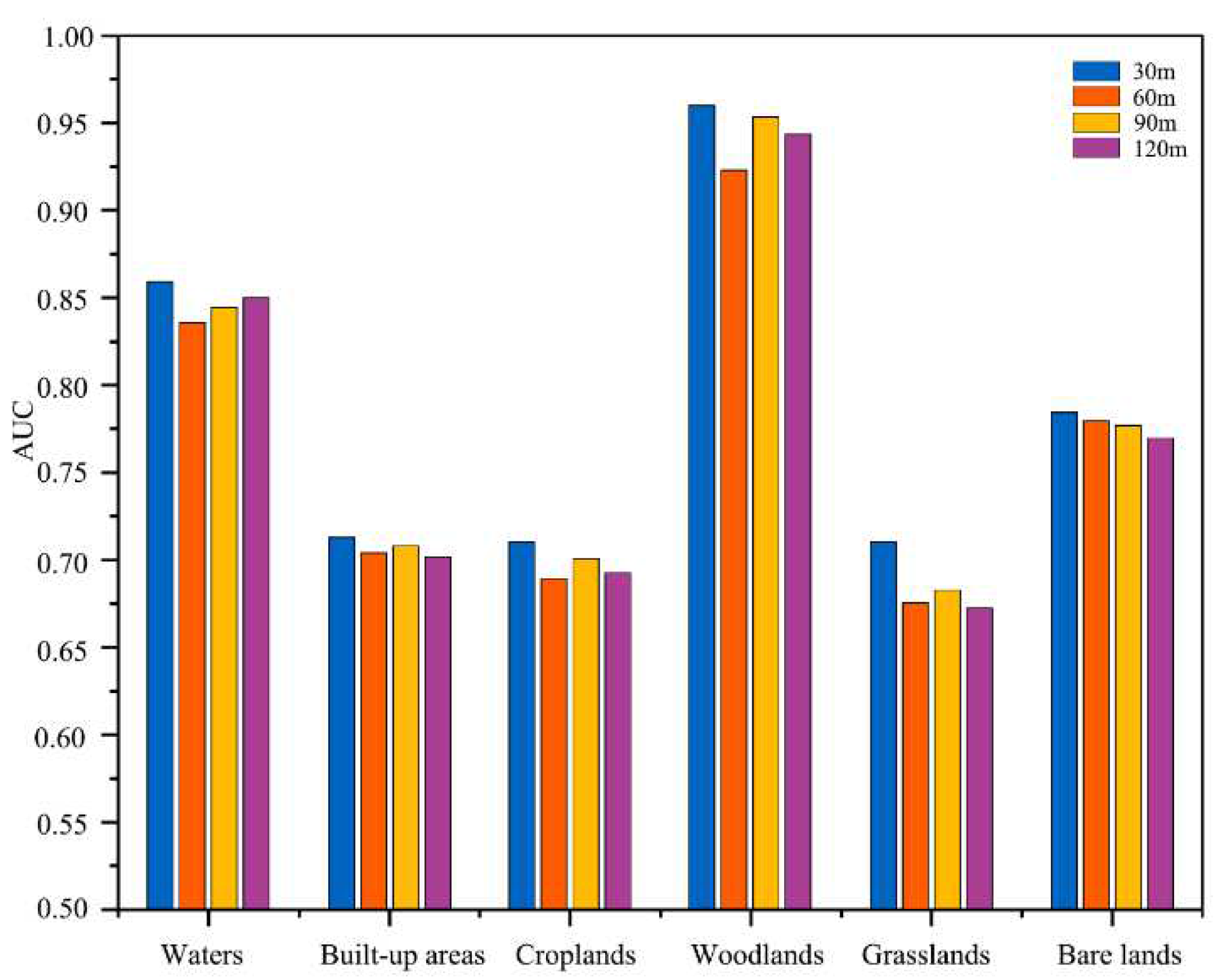
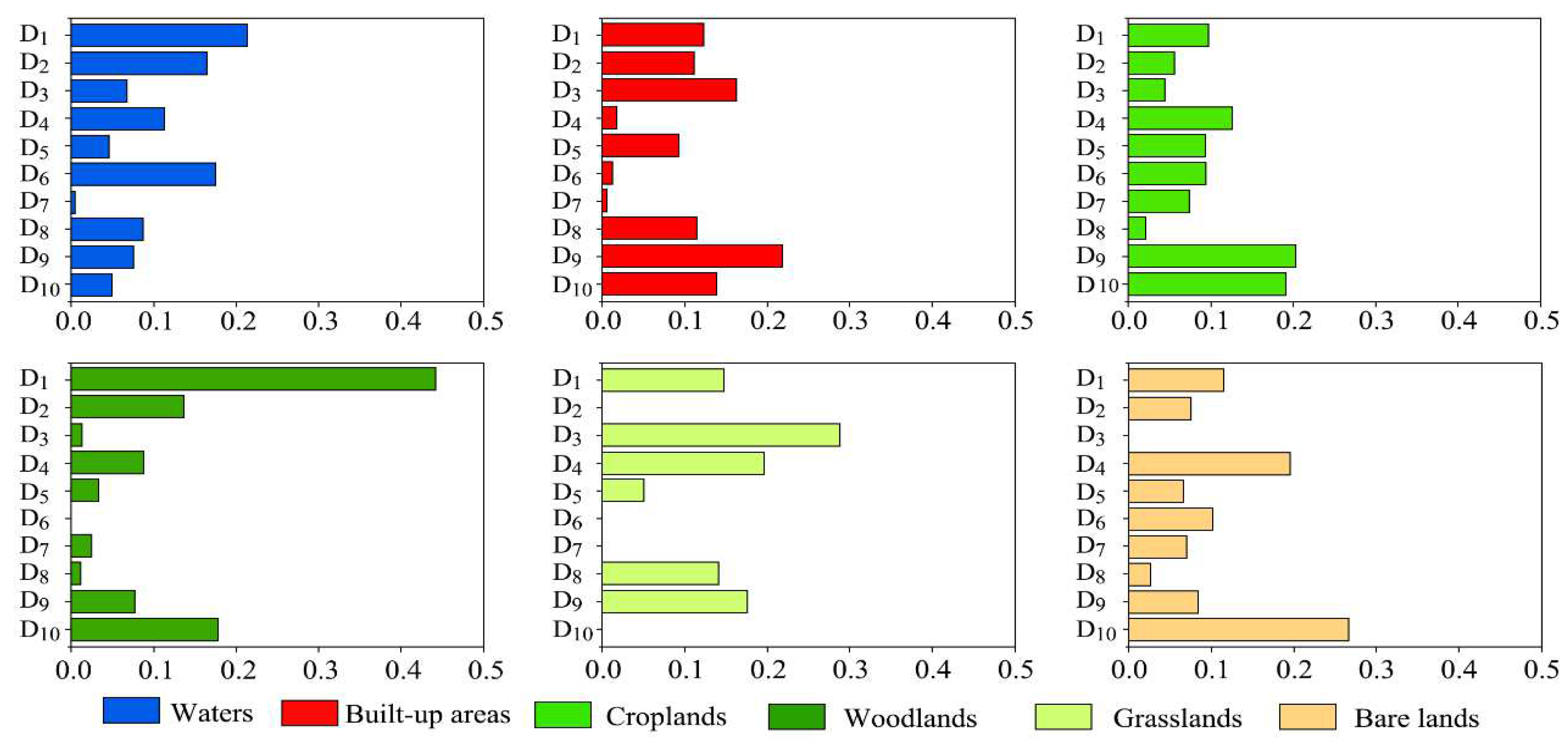

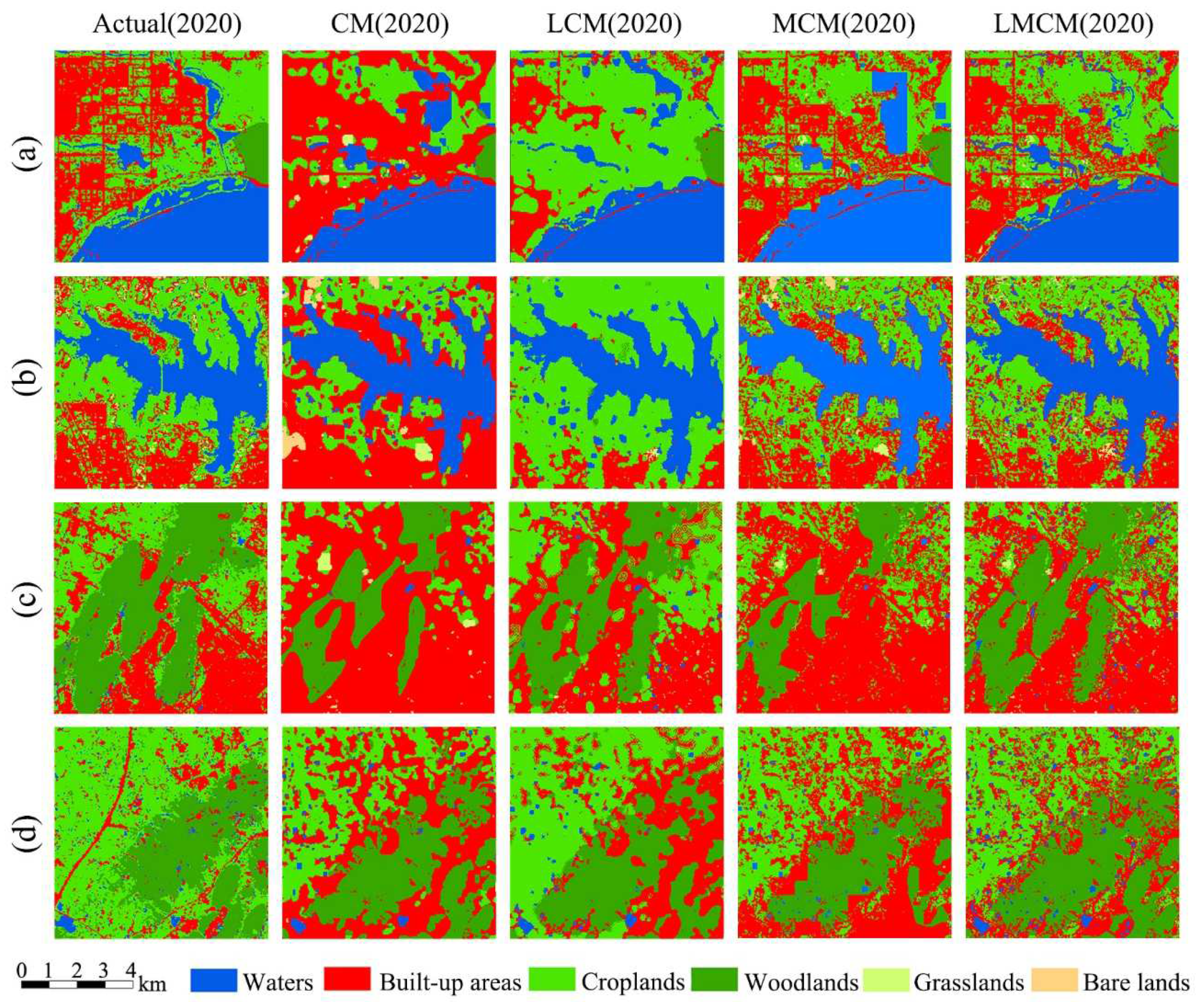
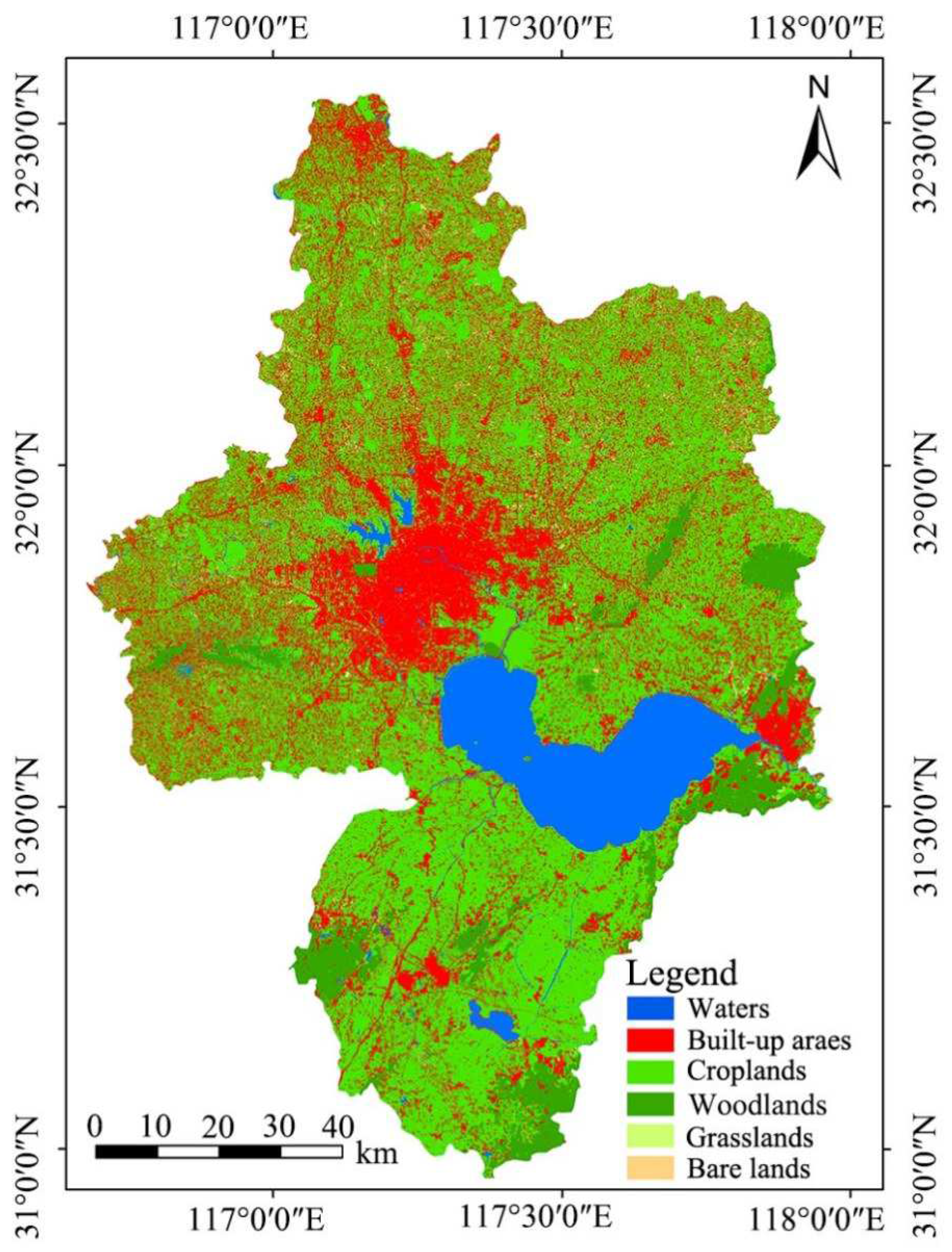
| Data Type | Data Content | Year | Spatial Resolution | Data Source |
|---|---|---|---|---|
| Remote Sensing Data | Landsat 5 TM | 2010 | 30 m × 30 m | USGS (https://glovis.usgs.gov, accessed on 1 April 2022) |
| Landsat 8 OLI | 2015 | |||
| Landsat 8 OLI | 2020 | |||
| Terrain Data | DEM | 2010 | 30 m × 30 m | NASA (https://www.earthdata.nasa.gov, accessed on 10 April 2022) |
| Socioeconomic Data | Population density | 2015 2020 | 30 m × 30 m | http://tjj.ah.gov.cn, accessed on 5 May 2022 |
| GDP | ||||
| Station-based Rainfall Data | Monthly rainfall | 2009–2021 | / | Data Center of Resources and Environment Science, the Chinese Academy of Sciences (CAS) (https://www.resdc.cn, accessed on 1 July 2023) |
| Basic Geographic Information Data | Road | 2015 2020 | 30 m × 30 m | OSM (http://www.openstreetmap.org, accessed on 10 May 2021) |
| Motorway | ||||
| Railway | ||||
| Lakes/Reservoir | ||||
| River | ||||
| Urban residential area | Obtained from Amap using API interface written by Java language | |||
| Planning Constraint Data | Protective zone of basic farmland | 2015 | Vector polygon | http://zrzyhghj.hefei.gov.cn, accessed on 1 July 2021 |
| Primary water source protection area | ||||
| National forest park | ||||
| Main urban built area | ||||
| Field Investigation Data | Field LUC observation points | 2021 | / | Using OvitalMap to conduct field surveys and record survey data for each observation point |
| Final Land Use Types | Descriptions |
|---|---|
| Waters | River channels, lakes, reservoirs, ponds, and wetlands |
| Built-up areas | Urban construction, rural settlements, industrial and mining areas, and infrastructures |
| Croplands | Paddy fields, other irrigated lands, and sown areas |
| Woodlands | Including local patches of forests, woodlands, and shrublands |
| Grasslands | Natural grasslands and pastures |
| Barelands | Bare soil and bare rocks |
| Factor Types | Potential Factors | Units | Variable Symbol |
|---|---|---|---|
| Natural factors | Elevation | m | D1 |
| Slope | ° | D2 | |
| Geographic factors | Distance to roads | m | D3 |
| Distance to motorways | m | D4 | |
| Distance to railways | m | D5 | |
| Distance to lakes/reservoirs | m | D6 | |
| Distance to rivers | m | D7 | |
| Distance to urban residential areas | m | D8 | |
| Socioeconomic factors | Population density | Persons/km2 | D9 |
| Average GDP per unit land | Yuans/ km2 | D10 | |
| Constraining factors | Protected farmlands | - | L1 |
| Protected areas of first-class water source | - | L2 | |
| National forest parks | - | L3 | |
| Main urban areas | - | L4 |
| Land Use Types | D1 | D2 | D3 | D4 | D5 | D6 | D7 | D8 | D9 | D10 |
|---|---|---|---|---|---|---|---|---|---|---|
| Waters | 2.139 | 1.793 | 1.163 | 1.702 | 1.595 | 1.255 | 1.437 | 1.235 | 6.961 | 7.304 |
| Built-up areas | 1.750 | 1.477 | 1.198 | 1.544 | 1.698 | 1.122 | 1.380 | 1.131 | 5.355 | 5.637 |
| Croplands | 1.978 | 1.745 | 1.157 | 1.513 | 1.607 | 1.118 | 1.338 | 1.128 | 5.738 | 6.061 |
| Woodlands | 2.101 | 1.958 | 1.190 | 2.074 | 2.123 | 1.301 | 1.315 | 1.238 | 7.021 | 7.607 |
| Grasslands | 1.912 | 1.538 | 1.181 | 1.466 | 1.632 | 1.123 | 1.459 | 1.127 | 7.023 | 7.256 |
| Barelands | 1.722 | 1.375 | 1.162 | 1.211 | 1.268 | 1.093 | 1.490 | 1.090 | 6.675 | 6.990 |
| Year | OA | KC | PA | UA |
|---|---|---|---|---|
| 2010 | 96.36% | 0.9329 | 96.36% | 99.18% |
| 2015 | 98.66% | 0.9733 | 98.66% | 98.66% |
| 2020 | 97.67% | 0.9566 | 97.67% | 97.67% |
| LUC Types | 2010 | 2015 | 2020 | LUC Changes (km2) | |||||
|---|---|---|---|---|---|---|---|---|---|
| Area (km2) | % | Area (km2) | % | Area (km2) | % | 2015–2010 | 2020–2015 | 2020–2010 | |
| Built-up Areas | 2094.75 | 18.35 | 2394.86 | 20.98 | 2899.44 | 25.40 | 300.11 | 504.58 | 804.69 |
| Waters | 1240.13 | 10.86 | 1296.46 | 11.36 | 1110.41 | 9.73 | 56.33 | −186.05 | −129.72 |
| Croplands | 7037.41 | 61.65 | 6734.75 | 58.99 | 6469.27 | 56.67 | −302.66 | −265.48 | −568.14 |
| Woodlands | 713.56 | 6.25 | 695.12 | 6.09 | 681.54 | 5.97 | −18.44 | −13.58 | −32.02 |
| Grasslands | 66.62 | 0.58 | 60.90 | 0.53 | 49.65 | 0.43 | −5.72 | −11.25 | −16.97 |
| Barelands | 263.71 | 2.31 | 234.09 | 2.05 | 205.87 | 1.80 | −29.62 | −28.22 | −57.84 |
| Total | 11,416.18 | 100.00 | 11,416.18 | 100.00 | 11,416.18 | 100.00 | 0.00 | 0.00 | 0.00 |
| Kappa Values | CM | LCM | MCM | LMCM |
|---|---|---|---|---|
| Kno | 0.7786 | 0.7616 | 0.7984 | 0.8156 |
| Kstandard | 0.7166 | 0.6949 | 0.7398 | 0.7612 |
| Klocation | 0.7313 | 0.7092 | 0.7747 | 0.8025 |
| Types | Waters | Built-Up Areas | Croplands | Woodlands | Grasslands | Barelands |
|---|---|---|---|---|---|---|
| Area (km2) | 950.74 | 3342.83 | 6175.13 | 643.85 | 59.77 | 243.85 |
| Δ2025–2020 (km2) | −159.67 | 443.39 | −294.14 | −37.69 | 10.12 | 37.98 |
| Annual average change (km2) | −31.93 | 88.68 | −58.83 | 7.54 | 2.02 | 7.60 |
| Hybrid Model | Driving Factors | Constraining Factors | Expert Knowledge Integration | Analysis of Drivers and Constraining Factors |
|---|---|---|---|---|
| Markov Model | No | No | No | No |
| CM | No | No | No | No |
| LCM | Yes | No | No | LR |
| MCM | Yes | Yes | Yes | MCE |
| LMCM | Yes | Yes | No | LR, MCE |
Disclaimer/Publisher’s Note: The statements, opinions and data contained in all publications are solely those of the individual author(s) and contributor(s) and not of MDPI and/or the editor(s). MDPI and/or the editor(s) disclaim responsibility for any injury to people or property resulting from any ideas, methods, instructions or products referred to in the content. |
© 2023 by the authors. Licensee MDPI, Basel, Switzerland. This article is an open access article distributed under the terms and conditions of the Creative Commons Attribution (CC BY) license (https://creativecommons.org/licenses/by/4.0/).
Share and Cite
He, Y.; Wu, W.; Xie, X.; Ke, X.; Song, Y.; Zhou, C.; Li, W.; Li, Y.; Jing, R.; Song, P.; et al. Land Use/Cover Change Prediction Based on a New Hybrid Logistic-Multicriteria Evaluation-Cellular Automata-Markov Model Taking Hefei, China as an Example. Land 2023, 12, 1899. https://doi.org/10.3390/land12101899
He Y, Wu W, Xie X, Ke X, Song Y, Zhou C, Li W, Li Y, Jing R, Song P, et al. Land Use/Cover Change Prediction Based on a New Hybrid Logistic-Multicriteria Evaluation-Cellular Automata-Markov Model Taking Hefei, China as an Example. Land. 2023; 12(10):1899. https://doi.org/10.3390/land12101899
Chicago/Turabian StyleHe, Yecheng, Weicheng Wu, Xinyuan Xie, Xinxin Ke, Yifei Song, Cuimin Zhou, Wenjing Li, Yuan Li, Rong Jing, Peixia Song, and et al. 2023. "Land Use/Cover Change Prediction Based on a New Hybrid Logistic-Multicriteria Evaluation-Cellular Automata-Markov Model Taking Hefei, China as an Example" Land 12, no. 10: 1899. https://doi.org/10.3390/land12101899




